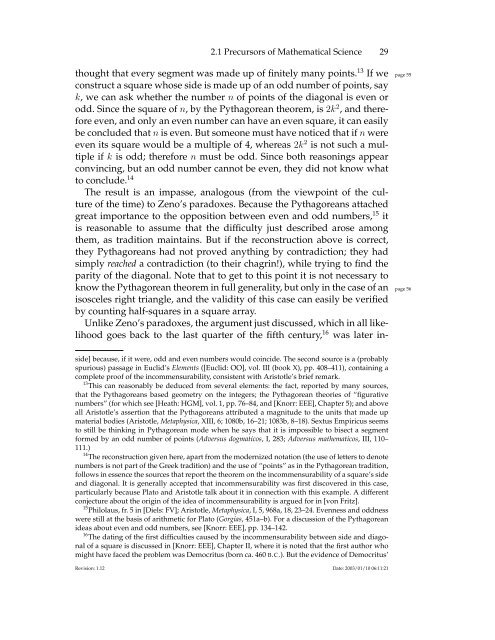1 The Birth of Science - MSRI
1 The Birth of Science - MSRI
1 The Birth of Science - MSRI
Create successful ePaper yourself
Turn your PDF publications into a flip-book with our unique Google optimized e-Paper software.
2.1 Precursors <strong>of</strong> Mathematical <strong>Science</strong> 29<br />
thought that every segment was made up <strong>of</strong> finitely many points. 13 If we page 55<br />
construct a square whose side is made up <strong>of</strong> an odd number <strong>of</strong> points, say<br />
k, we can ask whether the number n <strong>of</strong> points <strong>of</strong> the diagonal is even or<br />
odd. Since the square <strong>of</strong> n, by the Pythagorean theorem, is 2k 2 , and therefore<br />
even, and only an even number can have an even square, it can easily<br />
be concluded that n is even. But someone must have noticed that if n were<br />
even its square would be a multiple <strong>of</strong> 4, whereas 2k 2 is not such a multiple<br />
if k is odd; therefore n must be odd. Since both reasonings appear<br />
convincing, but an odd number cannot be even, they did not know what<br />
to conclude. 14<br />
<strong>The</strong> result is an impasse, analogous (from the viewpoint <strong>of</strong> the culture<br />
<strong>of</strong> the time) to Zeno’s paradoxes. Because the Pythagoreans attached<br />
great importance to the opposition between even and odd numbers, 15 it<br />
is reasonable to assume that the difficulty just described arose among<br />
them, as tradition maintains. But if the reconstruction above is correct,<br />
they Pythagoreans had not proved anything by contradiction; they had<br />
simply reached a contradiction (to their chagrin!), while trying to find the<br />
parity <strong>of</strong> the diagonal. Note that to get to this point it is not necessary to<br />
know the Pythagorean theorem in full generality, but only in the case <strong>of</strong> an page 56<br />
isosceles right triangle, and the validity <strong>of</strong> this case can easily be verified<br />
by counting half-squares in a square array.<br />
Unlike Zeno’s paradoxes, the argument just discussed, which in all likelihood<br />
goes back to the last quarter <strong>of</strong> the fifth century, 16 was later in-<br />
side] because, if it were, odd and even numbers would coincide. <strong>The</strong> second source is a (probably<br />
spurious) passage in Euclid’s Elements ([Euclid: OO], vol. III (book X), pp. 408–411), containing a<br />
complete pro<strong>of</strong> <strong>of</strong> the incommensurability, consistent with Aristotle’s brief remark.<br />
13 This can reasonably be deduced from several elements: the fact, reported by many sources,<br />
that the Pythagoreans based geometry on the integers; the Pythagorean theories <strong>of</strong> “figurative<br />
numbers” (for which see [Heath: HGM], vol. 1, pp. 76–84, and [Knorr: EEE], Chapter 5); and above<br />
all Aristotle’s assertion that the Pythagoreans attributed a magnitude to the units that made up<br />
material bodies (Aristotle, Metaphysica, XIII, 6; 1080b, 16–21; 1083b, 8–18). Sextus Empiricus seems<br />
to still be thinking in Pythagorean mode when he says that it is impossible to bisect a segment<br />
formed by an odd number <strong>of</strong> points (Adversus dogmaticos, I, 283; Adversus mathematicos, III, 110–<br />
111.)<br />
14 <strong>The</strong> reconstruction given here, apart from the modernized notation (the use <strong>of</strong> letters to denote<br />
numbers is not part <strong>of</strong> the Greek tradition) and the use <strong>of</strong> “points” as in the Pythagorean tradition,<br />
follows in essence the sources that report the theorem on the incommensurability <strong>of</strong> a square’s side<br />
and diagonal. It is generally accepted that incommensurability was first discovered in this case,<br />
particularly because Plato and Aristotle talk about it in connection with this example. A different<br />
conjecture about the origin <strong>of</strong> the idea <strong>of</strong> incommensurability is argued for in [von Fritz].<br />
15 Philolaus, fr. 5 in [Diels: FV]; Aristotle, Metaphysica, I, 5, 968a, 18, 23–24. Evenness and oddness<br />
were still at the basis <strong>of</strong> arithmetic for Plato (Gorgias, 451a–b). For a discussion <strong>of</strong> the Pythagorean<br />
ideas about even and odd numbers, see [Knorr: EEE], pp. 134–142.<br />
16 <strong>The</strong> dating <strong>of</strong> the first difficulties caused by the incommensurability between side and diagonal<br />
<strong>of</strong> a square is discussed in [Knorr: EEE], Chapter II, where it is noted that the first author who<br />
might have faced the problem was Democritus (born ca. 460 B.C.). But the evidence <strong>of</strong> Democritus’<br />
Revision: 1.12 Date: 2003/01/10 06:11:21










